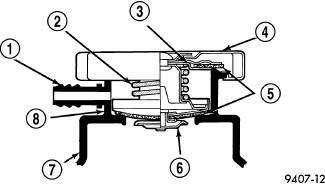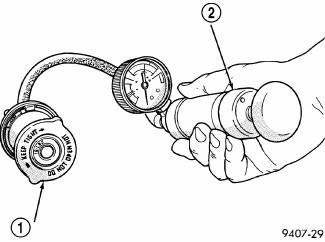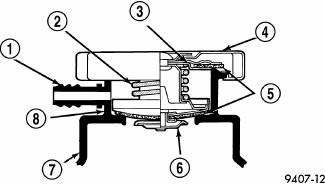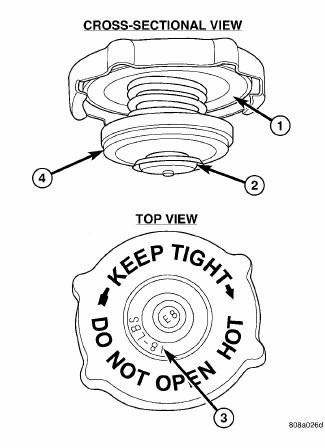Dodge Journey: Cap, radiator
Description

Fig. 58: Cooling System Pressure Cap
- - OVERFLOW NIPPLE
- - MAIN SPRING
- - GASKET RETAINER
- - STAINLESS-STEEL SWIVEL TOP
- - RUBBER SEALS
- - VENT VALVE
- - COOLANT OUTLET CONNECTOR (2.0L/2.4L)/PRESSURE CONTAINER (2.7L)
- - FILLER NECK
Operation
The pressure cap allows the cooling system to operate at higher than atmospheric pressure. The higher pressure raises the coolant boiling point; this allows increased radiator cooling capacity.
The gasket in the cap seals the filler neck, so that vacuum can be maintained, allowing coolant to be drawn back into the cooling system from the reserve container.
Diagnosis and Testing
RADIATOR PRESSURE CAP TESTING

Fig. 59: Testing Cooling System Pressure Cap
- - PRESSURE CAP
- - PRESSURE TESTER
CAUTION: Vehicles equipped with 2.4L engines use a different pressure cap than vehicles equipped with 2.7L engines. The pressure caps are NOT interchangeable. Verify proper pressure cap part number.
Dip the pressure cap in water. Clean any deposits off the vent valve or its seat and apply cap to end of the Pressure Cap Test Adaptor that is included with the Cooling System Tester 7700. Working the plunger, bring the pressure to 104 kPa (15 psi) on the gauge. If the pressure cap fails to hold pressure of at least 97 kPa (14 psi), replace the pressure cap.
CAUTION: The Cooling System Tester Tool is very sensitive to small air leaks that will not cause cooling system problems. A pressure cap that does not have a history of coolant loss should not be replaced just because it leaks slowly when tested with this tool. Add water to the tool. Turn tool upside down and recheck pressure cap to confirm that cap is bad.
If the pressure cap tests properly while positioned on Cooling System Tester but will not hold pressure or vacuum when positioned on the filler neck. Inspect the filler neck and cap top gasket for irregularities that may prevent the cap from sealing properly.
PRESSURE RELIEF TESTING

Fig. 60: Cooling System Pressure Cap
- - OVERFLOW NIPPLE
- - MAIN SPRING
- - GASKET RETAINER
- - STAINLESS-STEEL SWIVEL TOP
- - RUBBER SEALS
- - VENT VALVE
- - COOLANT OUTLET CONNECTOR (2.0L/2.4L)/PRESSURE CONTAINER (2.7L)
- - FILLER NECK
WARNING: The warning words "DO NOT OPEN HOT" on the pressure cap is a safety precaution. When hot, the cooling system builds up pressure. To prevent scalding or other injury, the pressure cap should not be removed while the system is hot and/or under pressure.
CAUTION: Vehicles equipped with 2.4L engines use a different pressure cap than vehicles equipped with 2.7L engines. The pressure caps are NOT interchangeable. Verify proper pressure cap part number.
The pressure cap upper gasket to filler neck seal can be checked by removing the overflow hose at the filler neck overflow nipple. Attach the radiator pressure tester to the filler neck overflow nipple, and pump air into the system. The pressure cap upper gasket should relieve pressure at 69-124 kPa (10-18 psi), and hold pressure at 55 kPa (8 psi) minimum.
There is no need to remove the pressure cap at any time except for the following purposes:
- Check and adjust coolant freeze point
- Refill system with new coolant
- Conducting service procedures
- Checking for leaks
WARNING: If vehicle has been run recently, wait 15 minutes before removing cap.
Place a shop towel over the cap, and without pushing down, rotate it counterclockwise to the first stop. Allow fluids to escape through the overflow tube. When the system stops pushing coolant and steam into the coolant recovery tank and pressure drops, push down on the cap and remove it completely. Squeezing the radiator inlet hose with a shop towel (to check pressure) before and after turning to the first stop is recommended.
Cleaning
Use only a mild soap to clean the pressure cap.
Inspection

Fig. 61: Cooling System Pressure Cap - Typical
- - FILLER NECK SEAL
- - VACUUM VENT VALVE
- - PRESSURE RATING
- - PRESSURE VALVE
Hold the cap in your hand, right side up . The vent valve at the bottom of the cap should fall open. Turn the cap upside down. The vent valve should close.
Replace the cap for any of the following conditions:
- Rubber gasket has swollen, preventing the valve from opening.
- Any light can be seen between the vent valve and the rubber gasket (with cap upside down).
- Gasket on the bottom of the cap shows noticeable thinning.
- Cap has been through more than one engine overheat.
 Bottle, coolant recovery
Bottle, coolant recovery
Description
NON-PRESSURE
Fig. 52: NON-PRESSURE COOLANT RECOVERY CONTAINER
- COOLANT RECOVERY CONTAINER
- OVERFLOW HOSE
- RADIATOR PRESSURE CAP
The coolant recovery system used on 2.4L e ...
 Coolant
Coolant
Description
ENGINE COOLANT
GAS ENGINES
WARNING: Antifreeze is an ethylene glycol based coolant and is
harmful if swallowed
or inhaled. If swallowed, drink two glasses of water and ind ...
See also:
Geartrain, planetary
DESCRIPTION
Fig. 355: Identifying Planetary Geartrain Components
- FRONT SUN GEAR ASSEMBLY
- #6 THRUST BEARING
- #7 THRUST BEARING
- REAR CARRIER/FRONT ANNULUS ASSEMBLY
- REAR SUN GEAR
...
AUTOMATIC TRANSMISSION
CAUTION:
Damage to the transmission may occur if the following
precautions are not observed:
• Shift into PARK only after the vehicle has come to
a complete stop.
• Shift into or out of REVER ...
Radiator, engine cooling
Description
Fig. 99: COOLING SYSTEM - OVERVIEW
- WINDSHIELD WASHER RESERVOIR
- UPPER SUPPORT
- FAN SHROUD
- FAN MOTOR
- LOWER RADIATOR HOSE
All vehicles are equipped with a cross flo ...
